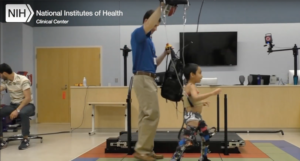The new robotic aides are designed to be used by parents, therapists and other healthcare professionals for the development and learning of individuals with neurodevelopmental or intellectual challenges
Myomo reaches $3.1 million in sales in second quarter
Myomo recognized revenue on 80 units in the second quarter, an increase of 233% compared with the second quarter of 2020.
This exoskeleton could eliminate crouch gait
The first robotic exoskeleton that is designed to treat crouch gait in children who have cerebral palsy, has been created by The National Institute of Health. Crouch gait occurs when there is an excessive bending of the knees while walking. It is a common condition in children with cerebral palsy. The NIH reports that even with…
Soft, water-powered robot makes endoscopic surgery easier
Harvard researchers have created a rigid-soft robotic arm for endoscopes that can sense, flex and has multiple degrees of freedom. Flexible endoscopes fit through narrow passages to reach difficult parts of the body. Once they reach their target, the devices need rigid surgical tools to be able to manipulate or remove tissues. Researchers from Harvard’s…
Worcester Polytechnic Institute launches smart medical devices program
Worcester Polytechnic Institute (WPI) has announced the launch of its new PracticePoint program that is designed to bring research, development and testing of medical devices under one roof. PracticePoint, with $17 million in initial funding, will focus on creating smart and secure medical devices that can interact with the physical world and improve patient-centric care.…
7 medtech stories we missed this week: July 21, 2017
From Second Sight’s South Korean market entry to Sanuwave’s Indonesian distribution deal, here are seven medtech stories we missed this week but thought were still worth mentioning. 1. Second Sight enters South Korea market Second Sight announced in a July 5 press release that it has entered the market in South Korea with the implantation…
This snake-like robot could be used for colonoscopies
Ben-Gurion University researchers are working on creating an ingestible snake-like robot that can navigate through the small intestine for a robotic colonoscopy. The tiny, swallowable robot, deemed SAW (single actuator wave-like robot), moves in a wave motion and is able to move through the environment of the small intestine. “The external shape of the robot…
6 surgical robots that will surprise you
Researchers around the globe have created surgical robots for solutions to procedures that are generally invasive and time-consuming. Whether its eye surgery or even finding a vein to draw blood, healthcare practitioners face daunting tasks, but robots have made these procedures easier (as easy as the DaVinci makes it look when peeling a grape and…
6 brain-controlled devices helping people regain movement
People who have lost feeling in their limbs or have lost the ability to move them may soon have those sensations restored thanks to a slew of recent brain-controlled device innovations. While we are moving toward less invasive methods like electrode-filled caps on the head, there are still more invasive implants that are benefiting those…
6 ways hydrogels are enabling medtech innovation
Hydrogels are water-based biomaterials developed specifically for human use, according to a Biomaterials journal article. They are a water-swollen polymeric material that doesn’t change its distinct 3D structure. They are formed from super-absorbent, chain-like polymers and are not soluble in water. However, their porous surface allows for nutrients and cell waste to pass through. They have shown the…
7 medtech stories we missed this week: March 31, 2017
This week we saw a few FDA 510(k) clearances and one of the 1st uses of a next-generation surgical robot in Asia. Here are 7 medtech stories we missed this week but thought were still worth mentioning: 1. Corindus touts first Asian use of next-generation robot Corindus Vascular Robotics announced in a March 31 press…
Mind-controlled robots read your mind to correct errors
Massachusetts Institute of Technology’s Computer Science and Artificial Intelligence Laboratory (CSAIL) and Boston University have developed a system that allows humans to direct and correct robots using only their brains. The system uses an electroencephalography (EEG) monitor to record brain activity that the system can detect when the user notices that there was an error…
9 cardiology breakthroughs you need to know
Cardiology breakthroughs couldn’t come soon enough because heart disease is the No. 1 killer of men and women in the U.S. About 610,000 Americans die of heart disease per year, and an additional 735,000 Americans suffer from a heart attack. The statistics terrify. About 610,000 Americans die of heart disease per year, and an additional…
MIT creates gentle robot that works using water
Massachusetts Institute of Technology engineers have created a robot that is made of hydrogels and powered by water that has the potential to be used in surgical applications. Tough, rubbery and mostly water, these robots can perform an array of tasks including kicking a ball or grabbing and releasing live fish. The transparent robots move…
Here’s how exosuits affect your joints
People who wear soft exosuits use 23% less energy when walking while also reducing stress on their ankle joints, according to a recently published study out of Harvard. The researchers previously showed that a soft robotic exosuit could lower energy expenditures in healthy people who need to carry things on their backs, but the new research shows…




